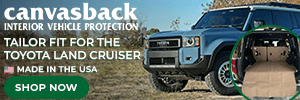Hi all! I got my 25 Land Cruiser LC trim a month ago and have been slowly buying essentials. Wondering what recommendations folks have for recovery tow ropes? What minimum (hoping to avoid anything excessively big and space occupying) tow rope capacity do people use? Sounds like some people like soft shackles? Many thanks for the advice!
Navigation
Install the app
How to install the app on iOS
Follow along with the video below to see how to install our site as a web app on your home screen.
Note: This feature may not be available in some browsers.
More options
You are using an out of date browser. It may not display this or other websites correctly.
You should upgrade or use an alternative browser.
You should upgrade or use an alternative browser.
What tow rope setups do folks recommend?
- Thread starter TLCBenji
- Start date
- Moderator
- #2
I used to have tow straps and cheapo tow ropes, after watching some off road recovery UT videos, I bit the bullet and purchased a "Yankum Rope" 7/8" kenotic rope, it was spendy! I now have 2 of their 7/8 x 30 ft ropes. I also purchased 150' of 5/8" AmSteel-Blue bulk rope, a factor 5 splicing fid and made my own winch extension and several bridles of various lengths, along with some "extra long" soft shackles. I had several metal pulleys and "bow shackles" but after watching the UT videos, I purchased 3 synthetic donut pulleys for re-directs and mechanical advantage rigging. I kept the metal stuff but I haven't used them since I went synthetic. No regrets!
A little "spendy" but buy good stuff once and never worry about it. I've had the following in my recovery bag now from before I had the LC and never failed me. Weight ratings work for the LC too thankfully!
- Yankum 7/8" x 30' "Python" kinetic rope
- Their 3" x 20' flat tow strap
- Four of their 7/16" soft shackles
Kinetic ropes are 100% the way to go. So much kinder on the vehicles from a force application perspective, and even when you dont need the kinetic effect, you can just slowly add tension and use it as a conventional pull (deep mud with suction for instance). I have been stuck and gotten others unstuck many times in sandy washes here in Az. Kinetic changed the game. The recommendations above are spot on.
4WD Instructor here, for what that's worth. Minimum gear for a 250, assuming you have a second vehicle:
1. Rated Recovery points for the front. The stock ones are not for lateral loads, they are for tieing down, not pulling out. They could work in a pinch, but combined with a kinetic strap? Thar be dragons.
2. Receiver type recovery point for the rear of your vehicle/rescue vehicle. Worst case? You can use a rated hitch pin. Never use a tow ball as a recovery point unless you want a cannonball coupe de grace.
3. Kinetic Recovery Rope is a good choice if you only have one option. Best for mud, sand and snow where you have suction issues. Not great among rocks, where the shock load will only pull a vehicle into an obstacle. Best case is also a recovery strap for when the stretch is not ideal.
4. A set of soft shackles. Never tie a tow-rope, as knots reduce the strength of a line or strap. These are lightweight and won't make a projectile in a failure.
5. Patience and training. Don't rush a vehicle recovery and don't wing it. I can't think of another situation where a "Good Samaritan" can do so much damage. Maybe a ball point pen tracheotomy? Check out The Driving Company Off Road EVOC Training. (I am not affiliated, but have attended their trainings in the past and found them to be better than excellent.)
For all this gear, brand matters. You can get cheaper alternatives sure, but, it is just not worth it. Warn, ARB etc. Companies with a robust testing program are worth the coin. Avoid Harbor Fright. (that was not typo, although, admittedly, they do seem to be improving).
Good for you for trying to be prepared. Semper Paratus shipmates.
1. Rated Recovery points for the front. The stock ones are not for lateral loads, they are for tieing down, not pulling out. They could work in a pinch, but combined with a kinetic strap? Thar be dragons.
2. Receiver type recovery point for the rear of your vehicle/rescue vehicle. Worst case? You can use a rated hitch pin. Never use a tow ball as a recovery point unless you want a cannonball coupe de grace.
3. Kinetic Recovery Rope is a good choice if you only have one option. Best for mud, sand and snow where you have suction issues. Not great among rocks, where the shock load will only pull a vehicle into an obstacle. Best case is also a recovery strap for when the stretch is not ideal.
4. A set of soft shackles. Never tie a tow-rope, as knots reduce the strength of a line or strap. These are lightweight and won't make a projectile in a failure.
5. Patience and training. Don't rush a vehicle recovery and don't wing it. I can't think of another situation where a "Good Samaritan" can do so much damage. Maybe a ball point pen tracheotomy? Check out The Driving Company Off Road EVOC Training. (I am not affiliated, but have attended their trainings in the past and found them to be better than excellent.)
For all this gear, brand matters. You can get cheaper alternatives sure, but, it is just not worth it. Warn, ARB etc. Companies with a robust testing program are worth the coin. Avoid Harbor Fright. (that was not typo, although, admittedly, they do seem to be improving).
Good for you for trying to be prepared. Semper Paratus shipmates.
Seems kind of standard from the above posts But I always carry a Kinetic rope, soft shackles, flat tow strap and a hitch receiver tow point. Would recommend not cheeping out when you are dealing with recovery gear as recovery can go south fast and failures can kill.
- Thread starter
- #7
Thanks everyone for the rapid responses! Much appreciated
Can you provide more detail here? I wasn't aware that the stock front recovery points were not appropriate for... recovery! Not doubting you, but I'm very interested to learn how and why they are deficient in case I ever find myself needing them.1. Rated Recovery points for the front. The stock ones are not for lateral loads, they are for tieing down, not pulling out. They could work in a pinch, but combined with a kinetic strap? Thar be dragons.
Sure thing. The loops under the truck at the front are really for towing, i.e. securing to a tow truck or when they were shipped over from Japan. I should also say that this is debated constantly. That's why they are called tow hooks, These are designed to take a pull down. Most manufactures won't make any claims about what forces these points can be expected to handle. But, most towing is done in neutral and at low speeds. These are for towing not yanking.Can you provide more detail here? I wasn't aware that the stock front recovery points were not appropriate for... recovery! Not doubting you, but I'm very interested to learn how and why they are deficient in case I ever find myself needing them.
Also, often they are sometimes not suitable because of manufacturing burrs or hard edges that can cause chaffing of soft shackles. The hooks on the 250 are much better than most. But, if you are planning to need them often, investing in a set of suitable after market may be worth it.
Another note here...might be making this more complicated....here goes anyway,
If the LC is the rescue vehicle, never use a truck in reverse to rescue someone if it can be avoided. This is because of the lay of gears in your differential. They are more prone to failure when loading them in reverse. Turn the rescue vehicle around and pull using the rear of the LC.
Similar threads
- Replies
- 4
- Views
- 5K
- Replies
- 28
- Views
- 13K
- Replies
- 13
- Views
- 7K


